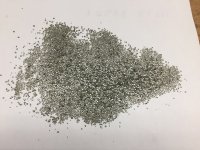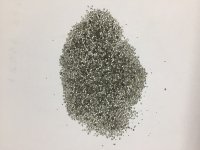You are using an out of date browser. It may not display this or other websites correctly.
You should upgrade or use an alternative browser.
You should upgrade or use an alternative browser.
Can You Identify This Powder?
- Thread starter Mcav8tr
- Start date
random guy
New member
Definitely gunpowder. Maybe.
Stats Shooter
New member
It's really hard to tell what powder something is by looking at it. There are 3 basic pistol and rifle powder shapes....They are ball(aka spherical), flake, and extruded (aka stick).
That powder right there is a ball powder. Beyond that I can't say anything for certain. Could be CFE, BL-C2, win xxx.....It's hard to say. .
It's not as dangerous as some folks make it out to be. If you are trying to duplicate a factory load, just shoot the factory load over the chroney, then disassemble several getting a powder weight, case deminsion, and powder used...Make sure you reference a manual for the powder YOU THINK it is ensuing it is safe for that bullet/cartridge. Then start low and work up.....No big deal.
I did this very thing to duplicate federal GMM
But just remember , even if you guess correctly, cannister grade powder used by an ammo company may be different than what you buy off the shelf.
That powder right there is a ball powder. Beyond that I can't say anything for certain. Could be CFE, BL-C2, win xxx.....It's hard to say. .
It's not as dangerous as some folks make it out to be. If you are trying to duplicate a factory load, just shoot the factory load over the chroney, then disassemble several getting a powder weight, case deminsion, and powder used...Make sure you reference a manual for the powder YOU THINK it is ensuing it is safe for that bullet/cartridge. Then start low and work up.....No big deal.
I did this very thing to duplicate federal GMM
But just remember , even if you guess correctly, cannister grade powder used by an ammo company may be different than what you buy off the shelf.
Last edited:
Sunday Shooter
New member
I know exactly what it is....lawn/garden fertilizer.
Why risk damage to your gun or injury to yourself?
Why risk damage to your gun or injury to yourself?
the possum
New member
I don't know why the OP wants to know this information. But I'll give him the benefit of the doubt that he's not gonna do something stupid. If he is, then at least get it on video! 
In case others reading ever want to identify a powder, check out the Smokeless Powder Database maintained by the National Center for Forensic Science. http://www.ilrc.ucf.edu/powders/ They have hundreds of powders in their library, where you can compare the pictures and specs.
In case others reading ever want to identify a powder, check out the Smokeless Powder Database maintained by the National Center for Forensic Science. http://www.ilrc.ucf.edu/powders/ They have hundreds of powders in their library, where you can compare the pictures and specs.
ShootistPRS
New member
There are too many variables to identify the exact powder by looks alone.
It does appear to be a flattened ball powder but you would need to know its density to even get close to a proper identification.
It is best used to fertilize the flower garden or lawn with it.
You can also burn it in small open piles.
It does appear to be a flattened ball powder but you would need to know its density to even get close to a proper identification.
It is best used to fertilize the flower garden or lawn with it.
You can also burn it in small open piles.
Definitely gunpowder. Maybe.
Heh; good way to make a point.
I say it's the country of Greenland.
Attempting to identify gunpowder by sight for any purpose other than personal amusement is highly ill-advised. For example, Bullseye and Power Pistol look identical - but they certainly don't interchange well in recipes.
I you want us to guess just for entertainment purposes, I think it looks a lot like Nitro 100. Kind of hard to tell with the lighting, but it seems to have that very pale white-ish color that I know to be N100. But again, it's just a guess.
One, it's not a ball powder as someone has said, but a flake powder like unfortunately at least a half dozen I could name off the top of my head. For that reason I would suggest you dispose of it. Lawn fertilizer would be one good use or spread it out thinly, preferably in a long thin line and toss a match on it and step back.
Paul B.
Paul B.
disseminator
New member
No, I cannot.
ShootistPRS
New member
As you see, we are having difficulty telling whether it is a cut flake or rolled (flattened) ball powder. HP-38 is a flattened ball powder. The spheres are rolled flat to increase the burn rate. Flake powders are cut so they are uniform in size and shape. Ball powders contain nitroglycerin up to about 15% added to the nitrocellulose for added energy while single base powders use a nitrocellulose base. Ball powders (double base powders) are denser than the single base powders.
There is no way to tell what you have without running tests on it and I would bet that few of us have the ability to perform the tests needed. It does make good fertilizer for non-food plants. Don't use it in the vegetable garden as it likely contains some materials you don't want in your leafy vegetables.
There is no way to tell what you have without running tests on it and I would bet that few of us have the ability to perform the tests needed. It does make good fertilizer for non-food plants. Don't use it in the vegetable garden as it likely contains some materials you don't want in your leafy vegetables.
random guy
New member
By chance, I nearly posted a similar question a few days ago. Just threw the powder sample away last night. It was from 5 rounds of a box of .40 S&W 180gr FMJ that shot very poorly. I took down 5 rounds and measured everything I could think of. The powder charges were impressively consistent. Bullet weight very close. Same for the primed cases. The only possible physical difference I could identify was that some bullets seemed to pull easier than others with an inertia puller.
I figured that the powder would be similar at least to some cannister powder that I had. I did not find any close match. It was a fine spherical of varying size grains. If anyone is curious, I'd be happy to take down another round.
The reason for this detective act:
Brand X 180gr FMJ
959
884
989
874
744
AV. 890 fps
M.E. 317 ft/lb
E.S. 245 fps
SD. 95
This from a 5" barrel M&P.
And a lot of vertical stringing as you might expect.
Charge weight was a very consistent 5.3 gr with one round at 5.4 gr.
My quess is that it is a light charge of a slower than optimum powder.
http://s107.photobucket.com/user/hvap90/media/Shooting/Fed 180 FMJ.jpg.html?sort=3&o=0
I figured that the powder would be similar at least to some cannister powder that I had. I did not find any close match. It was a fine spherical of varying size grains. If anyone is curious, I'd be happy to take down another round.
The reason for this detective act:
Brand X 180gr FMJ
959
884
989
874
744
AV. 890 fps
M.E. 317 ft/lb
E.S. 245 fps
SD. 95
This from a 5" barrel M&P.
And a lot of vertical stringing as you might expect.
Charge weight was a very consistent 5.3 gr with one round at 5.4 gr.
My quess is that it is a light charge of a slower than optimum powder.
http://s107.photobucket.com/user/hvap90/media/Shooting/Fed 180 FMJ.jpg.html?sort=3&o=0
Last edited:


